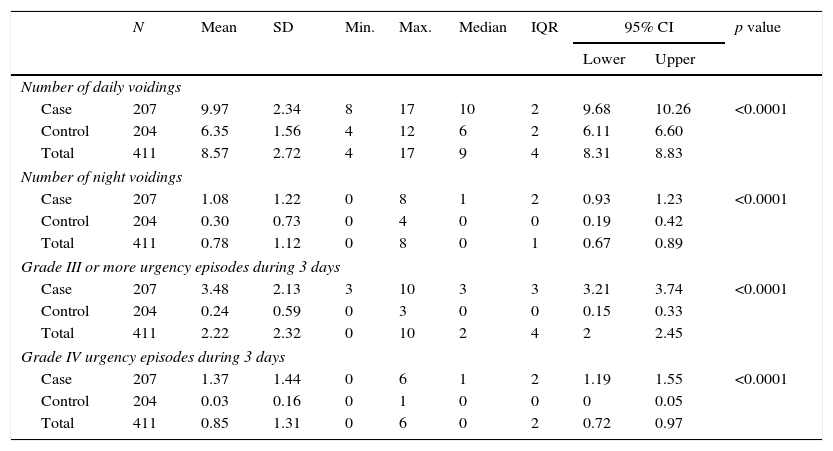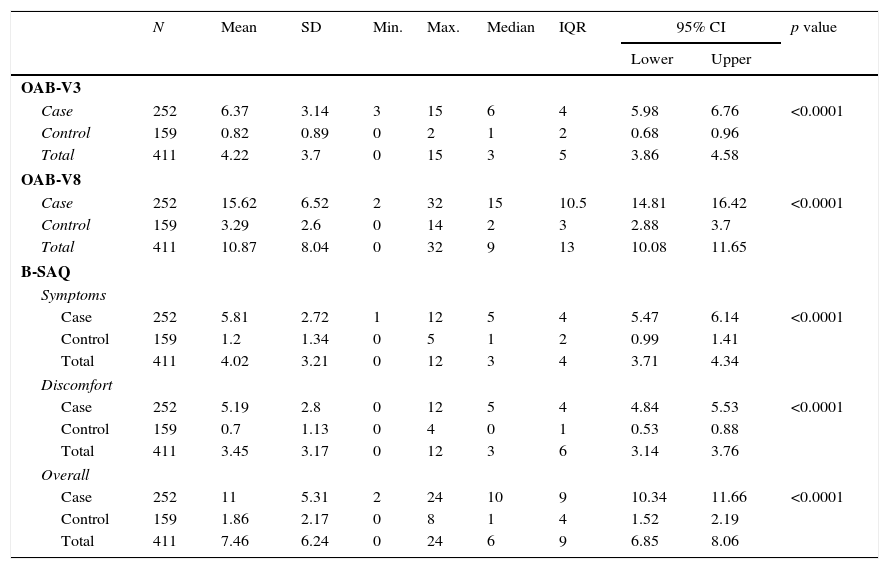To compare the capacity shown by 3 self-assessment questionnaires validated in Spanish (B-SAQ, OAB-V8 and OAB-V3) for the screening of patients with overactive bladder (OAB) in clinical practice.
Material and methodA noninterventional observational study was conducted of men and women older than 30 years evaluated in primary care consultations. The clinical diagnosis of OAB was conducted through a case history review, physical examination, urine analysis, ultrasonography and voiding diary. The presence of coping strategies and discomfort was investigated. The differential diagnosis was established in patients with symptoms not due to OAB. We assessed the correlation between the clinical tests and diagnosis (kappa<0.4 poor; 0.4–0.6 moderate; >0.6 good; >0.8 excellent) and ROC curves to define the capacity to screen the assessed questionnaires.
ResultsA total of 411 patients were investigated. OAB was detected in 207 (50.4%) patients, other causes for the lower urinary tract symptoms were detected in 63 (15.3%), and 141 (34.3%) patients had no diagnosis. The voiding diary suggested OAB in 197 (47.9%) patients. The correlation between the clinical diagnosis and the diagnosis based on the voiding diary was 0.702. The correlation between the clinical diagnosis and B-SAQ, OAB-V8 and OAB-V3 was 0.59, 0.673 and 0.732, respectively. The area under the curve (AUC) was 0.799 for B-SAQ; 0.837 for OAB-V8 and 0.867 for OAB-V3 (OAB-V3 vs. OAB-V8, p=0.02; OAB-V3 vs. B-SAQ, p<0.0001). The AUC for the voiding diary was 0.852 (OAB-V3 vs. diary, p=0.47).
ConclusionsOAB-V3 is a simple questionnaire with excellent performance for screening OAB in a specific population and that is superior to the OAB-V8 and B-SAQ. The accuracy of the voiding diary for the same indication is equivalent to that of the OAB-V3 in our setting.
Comparar en la práctica clínica la capacidad que muestran 3 cuestionarios de autoevaluación validados en castellano (CACV, OAB-V8 y OAB-V3) para el cribado de pacientes con vejiga hiperactiva (VH).
Material y métodoEstudio observacional no intervencionista en hombres y mujeres >30 años evaluados en consulta de atención primaria. El diagnóstico clínico de VH se realizó mediante anamnesis, exploración física, análisis de orina, ecografía y diario miccional. Se investigó la presencia de estrategias de afrontamiento y molestias. Se estableció diagnóstico diferencial en pacientes con síntomas no debidos a VH. Se evaluó correlación entre pruebas y diagnóstico clínico (kappa<0,4 pobre; 0,4-0,6 moderada; >0,6 bueno; >0,8 excelente) y curvas ROC para definir la capacidad para el cribado de los cuestionarios evaluados.
ResultadosCuatrocientos once sujetos fueron investigados. En 207 (50,4%) se detectó VH, en 63 (15,3%) otras causas de síntomas del tracto urinario inferior y en 141 (34,3%) ningún diagnóstico. El diario miccional sugirió VH en 197 (47,9%). La correlación entre diagnóstico clínico y diagnóstico basado en diario miccional fue 0,702. La correlación entre diagnóstico clínico y CACV, OAB-V8 y OAB-V3 fue 0,59, 0,673 y 0,732; respectivamente. El área bajo la curva (ABC) fue 0,799 para CACV; 0,837 OAB-V8 y 0,867 OAB-V3 (OAB-V3 vs OAB-V8, p=0,02; OAB-V3 vs CACV, p<0,0001). El ABC para diario miccional fue 0,852 (OAB-V3 vs diario, p=0,47).
ConclusionesOAB-V3 es un cuestionario sencillo con excelente rendimiento para el cribado de VH en una población concreta, superior a OAB-V8 y CACV. La exactitud del diario miccional para esta misma indicación resulta equivalente a la de OAB-V3 en nuestro entorno.
Artículo
Comprando el artículo el PDF del mismo podrá ser descargado
Precio 19,34 €
Comprar ahora












